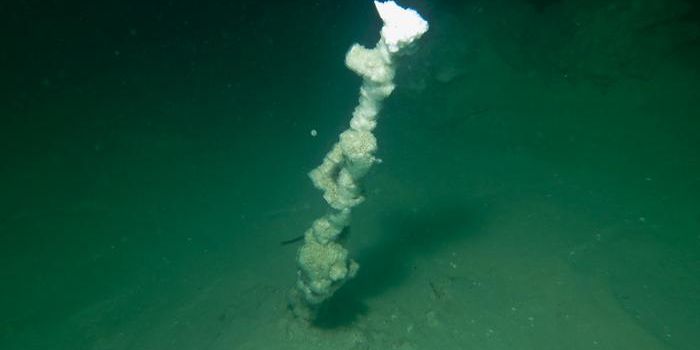Localized die-offs aren't even the most disruptive effect of depleted oxygen. "Changes in oxygen turn out to be really important in determining where organisms are and what they do," says marine biologist Francis Chan, also at Oregon State University. The fate of some odd little fish suggests the consequences can be enormous.
Into the Light
Since the 1950s, researchers every year have dropped nets 1,000 feet (300 meters) down to catalog marine life many miles off California. Most track commercially important species caught by the fishing industry. But J. Anthony Koslow tallies fish often credited with keeping marine systems functioning soundly-tiny midwater bristlemouths, the region's most abundant marine species, as well as viperfish, hatchetfish, razor-mouthed dragonfish, and even minnow-like lampfish.

All are significant parts of the seafood buffet that supports life in the eastern Pacific, and all are declining dramatically with the vertical rise of low-oxygen water.
"If it was a 10 percent change, it wouldn't have been worth noting, but they've declined by 63 percent," says Koslow, of the Scripps Institution of Oceanography. And "what's been amazing is it's across the board-eight major groups of deep-sea fishes declining together-and it's strongly correlated with declining oxygen."
Most of these fish spend their days swimming hundreds of feet down, just above low-oxygen water. Many are black, camouflaged by the dark, deep waters where light never reaches. They rise at night to feed on plankton.
Koslow can't say precisely why these fish populations have collapsed. But he suspects they, too, now spend more time closer to the surface seeking oxygen. That puts these fish during the day in a region where light penetrates, making them easier pickings for birds, marine mammals, rockfish, and other sight-feeders.
If that's the case, Koslow says, "the ramifications would be huge."
Such tiny fish are a massive food source around the world. Globally, they account for far more mass in the sea than the entire world's catch of fish combined. But there isn't enough historical data in other parts of the world to determine if the trend is unique to California.
"They are central to the ecology of the world's oceans," Koslow says.
Scientists suspect these fish already may be partly responsible for at least one surprising change-a massive northward expansion between 1997 and 2010 of the northern Pacific Ocean's most ravenous visitor, the Humboldt squid.
Once found from South America to Mexico, with occasional forays into California, the Humboldt squid has moved so far north that in recent years it has been seen off Alaska. Researchers tested squid in tanks and found low oxygen was hard on them, too, even though the jumbo squid could slow its metabolism. Yet here they were, faring so well at the edge of low-oxygen areas they had become a master predator of midwater fish.
"These squid are out-competing all the tunas and sharks and marine mammals that may want to feed in this zone," Stanford's Gilly says.
Researchers did not directly connect the expansion of the squid's feeding area to rising oxygen-poor water. But Koslow linked low-oxygen water to shifts in where the midwater fish on the squid's menu live. And scientists now can draw a direct line between where those fish went and the squid's northward march, Gilly says.
"I think there might be a sweet spot for Humboldt squid, where low oxygen, food, and light are in perfect balance-and that's accounting for their expansion," Gilly says.
Still, the squid's expansion was not subtle. Tracking its causes almost certainly is simpler than unspooling other impacts. And oxygen loss exacerbates other issues. Marine creatures need more oxygen in warmer waters, for example. Climate change means they increasingly will have less.
"I think we are changing the world; I just don't think the responses are going to be as predictable as we think," says Francisco Chavez, senior scientist with California's Monterey Bay Aquarium Research Institute. "I think there are a slew of surprises ahead."
And how low-oxygen areas will affect everything else depends on how much they spread.
Looking Back to See Ahead
To answer that question, scientists recently examined marine sediment cores from a period of glacial melt 17,000 to 11,000 years ago.
During that time, global average air temperatures rose 3 to 4 degrees Celsius, the closest historical analog for the projected future, says study co-author Tessa Hill, of the Bodega Marine Laboratory. "The idea here is ... let's take an interval with somewhat analogous warming and see how low-oxygen zones responded," Hill says.
The results: Low-oxygen areas exploded around the world.
"What we found is that their expansion was just extremely large and abrupt," says lead author Moffitt. "Their footprint across ocean basins grew much more than we had anticipated."
One low-oxygen region off Chile and Peru-combined, the two countries now have an anchovy fleet that makes up the world's largest single-species fishery-was much larger then, thousands of years ago. It stretched from 9,800 feet (3,000 meters) deep to within 490 feet (150 meters) of the surface. And off California, low-oxygen waters came far closer to the surface than they do today.
Their research showed that "environments we might think of as stable, like the deep ocean, may not be so stable at all," Moffitt says.
In the blink of an eye, geologically speaking, entire ocean basins changed. And many scientists suspect they are doing so once again, at a cost they can't yet quantify.
(Source: National Geographic)









